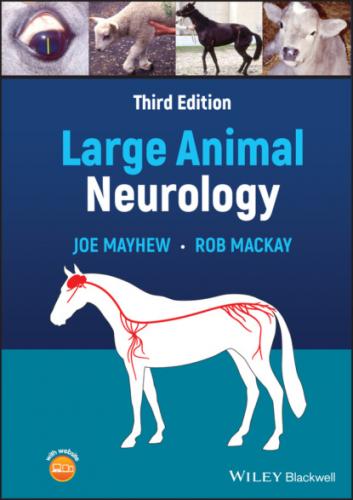Notable though usually inconsequential radiographic findings on equine cervical radiographs include the following:
Variations and asymmetry in the shape of the intervertebral notch or orifice at the cranial border of C2.
Irregularities to the dorsal aspect of the caudal physes of C2–C7 projecting into the intervertebral space.
Separate ossification of the caudal projection of the transverse processes of C6.
One or two transverse processes of C6 sometimes transferred onto C5 or onto C7.
Serpentine lucent vascular channels on the spine of C2.
Relative lucencies of the pedicles of the arches of the vertebral canal of C1 and C2.
Irregular border to the caudal aspect of the spine of C2.
Circular 3‐20 mm, cyst‐like lucencies occasionally present in the arches or bodies of all cervical vertebrae
Variable size of, and irregular dorsal border to spines of C3‐6
large and cranially‐projecting, irregularly‐mineralized, dorsal spinous process on C7 and T1
Figure 3.10 Magnetic motor evoked potential (mMEP) recording can be undertaken in the fully conscious cooperative patient or with the patient sedated with alpha‐2 and synthetic narcotic drugs. A magnetic stimulator (1) creates a very brief magnetic pulse in the attached coil (2) held centrally over the forebrain of the patient. At the onset of the stimulus, the generator triggers an electrodiagnostic unit (not shown—see Figure 3.9) to begin recording from the skin clip electrodes (3) placed over muscles such as cranial tibial (CT) and extensor carpi radialis (ECR) limb muscles. One or a few traces can be summated to produce mMEP waveforms that indicate the time for impulses to be produced in the brain motor centers and propagated along the central motor pathways to the peripheral nerves and ultimately the muscles from which a summated motor unit action potential can be recorded. Inset (4) shows a printout of the mMEP waveforms recorded from the ECR (top) and CT (bottom) muscles. Conduction times from stimulus till muscle response for these recordings were 24 ms to the ECR muscle and 46 ms to the CT muscle.
Figure 3.11 Radiographic evidence of a chronic lesion in the area of the occipital bursa such as the irregular mass of mineralized tissue seen here (arrows) has been suggested to be one cause for headshaking in horses. This horse was not a headshaker, and the radiographs were taken for other reasons.
Obtaining high‐quality radiographs is absolutely paramount to the accurate quantification of any measurements such as minimal sagittal diameter of the vertebral canal (Figure 3.12).96,109,110 Standardized oblique radiographic views (Figure 3.13) can be useful in lateralizing changes seen on vertebral (and skull) radiographs especially where DV views are difficult or impossible to obtain.97 Interpretation of plain radiographs of other large animal species111,112 is less frequently undertaken and thus more problematic113 such that control images often need to be consulted.18
Figure 3.12 Obtaining accurate measurements such as minimal sagittal diameters from radiographs does depend upon obtaining a true lateral projection and good exposure factors—the latter being more readily obtained with digital radiography. A and B are images from the same average quality, standing radiograph of the C3–4 intervertebral articulation of a yearling with CVM using different postprocess exposures. The sites that need to be precisely identified to accurately measure the sagittal ratios are indicated by circles in A and are very indistinct. With image manipulation, reasonable measurements can be obtained for the intravertebral (white bar) and intervertebral (yellow bar) sagittal diameters. Part of the problem with making measurements lies with the superimposition of structures including the pedicles of the articular processes overlying the laminae of the dorsal arch of the vertebral canal. Also blurred and paired lines of the dorsal and especially ventral margins of the vertebral canal due to obliquity, add to the imprecision of measurements.
Figure 3.13 Oblique lateral radiographs can assist in lateralizing alterations to vertebral articular processes in wobblers and horses suffering from neck pain and unusual thoracic limb gait abnormalities. This results in skyline views of the articular surfaces as shown here using a 34° (above lateral) oblique projection for one of the C2–3 articulations (between yellow arrows). One of the C3–4 articulations (between green arrows) is not quite as well defined on this projection as the more caudal cervical articular surfaces are on a greater angle such that at C6–7 the X‐ray beam needs to be directed from at least 45° above horizontal with the horse’s neck on a horizontal axis.
The techniques of positive contrast myelography have been described in large animals, particularly horses.103,114–122 These procedures are useful for defining spinal cord compression and swelling of the spinal cord, although experience is required to be able to obtain satisfactory studies (Figure 3.14). Complications do occur, and the procedures can be prolonged and distressing to the patient.123,124 Consequently, it is suggested that these procedures be performed only by an experienced radiographer who has the correct equipment and only when the clinician is prepared to attempt whatever surgical and medical approach is indicated, including euthanasia, as necessary at the end of the procedure. We do not condone performing positive contrast myelography on nonanesthetized large animal patients.125 Notwithstanding these issues, contrast myelography and subjective and objective assessment of measured parameters of compression of spinal cord taken from these studies are useful to define lesions prior to corrective surgical procedures being carried out99,121,126–132 and to help focus diagnostic postmortem studies.53,113, 133,134
